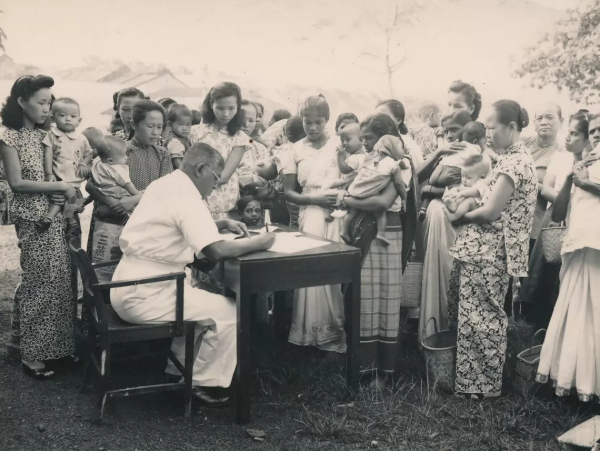This is an old revision of the document!
Table of Contents
British: Pasca Pendudukan Jepun (1940-1957)
Ringkasan
Selepas Pendudukan Jepun dan kembalinya pentadbiran British, kadar kematian bayi menurun secara mendadak. Faktor-faktornya ialah peningkatan mutu kesihatan awam dan sanitasi, pengawalan wabak malaria, penambahan inokulasi bayi, pengawasan bidan-bidan (ordinan 1954), penjagaan perubatan dan khidmat nasihat oleh klinik kesihatan ibu dan anak. (Lenore Manderson, International Journal of Health Services, Vol. 12, No. 4 (1982), pp. 597-616 (20 pages): |"BOTTLE FEEDING AND IDEOLOGY IN COLONIAL MALAYA: THE PRODUCTION OF CHANGE").

Pusat Kebajikan Bayi di Kuala Lumpur, 1954: “5th October 1954, Registration of babies at Babies Welfare Centre during the Activity at Medical Research Institute and Outside Division Building at Kuala Lumpur.” (Jabatan Penerangan Malaysia (JAPEN), 1954 @ UNICEF, 2024: |"UNICEF Malaysia: 70 years of prioritizing children").
Kronologi
1940-an: Hubungkait Susu Botol dengan Gejala Cirit Birit
Correlation of bottle feeding and jangkitan cirit birit pada bayinfantile gastroenteritis established by Levi and Alexander. Only since this time, doctors and governments became concerned with dangers of bottle feeding.
1941: Pendudukan Jepun
Supply of manufactured goods disrupted (Japanese occupation) - women had to breastfeed. British Medical Officers associated with improved infant mortality rate.
1945: British Kembali: Bekalan Susu
Situation returned with the British. Limited cow's milk supply through government agencies, so majority infants breastfed. Official correspondence immediately after reinstatement of British Administration: Chief Nutrition Adviser, 1948-11 (10, folio 8): “70,000-80,000 tons of dried milk would be required … for the expectant and nursing mothers, babies and children. Unfortunately the Nutrition Council, because of the cost of even this quantity of milk, feels this amount will have to be reduced still further. THe least additional quantity we can ask for is 10,000 tons … The council recommends that this extra milk should be powdered, skimmed milk since this is probably more easily and cheaply obtained… We believe the importation of extra milk is necessary to prevent disease and unrest in the country.” Regular supply resumed: Advertising returned.
1950-an: Iklan Untuk Khalayak Umum
Advertising start for the masses.
Akhir 1950-an: Iklan di Akhbar Melayu
Daily ads in Utusan Melayu: Cow and Gate, Lactogen, Klim, Every Day, Milkmaid. Also tonics, worm powders, chocolates, supplements, cough mixtures. In English press: Carnation Milk, Dutch Baby, Ostermilk (Glaxo) infant milks, compete with Cow and Gate & Nestle (Lactogen, Nestogen (low-fat infant food), Eledon buttermilk (premature underdeveloped babies), Gluco-B supplement, Nespray (older babies & general use), Nestum (cereal for weaning), Babex dehydrated fruit & vege (for weaning) ( e.g. ST 1959-07-07, p.4). New milk brands: Blue Cross, Baby Stork. New weaning fods: Farex, Barlova, Lacova. Pictures of Asian babies and testimonies from Asian mothers used. Ostermilk: 'especially suitable for babies in Malaysia' (ST 1957-07-16, p.7). Morinaga: 'good for infants, because it is just like mothers' own milk, and is especially suitable for Asian babies' (Berita Harian, 1963-09-16, p.15).
